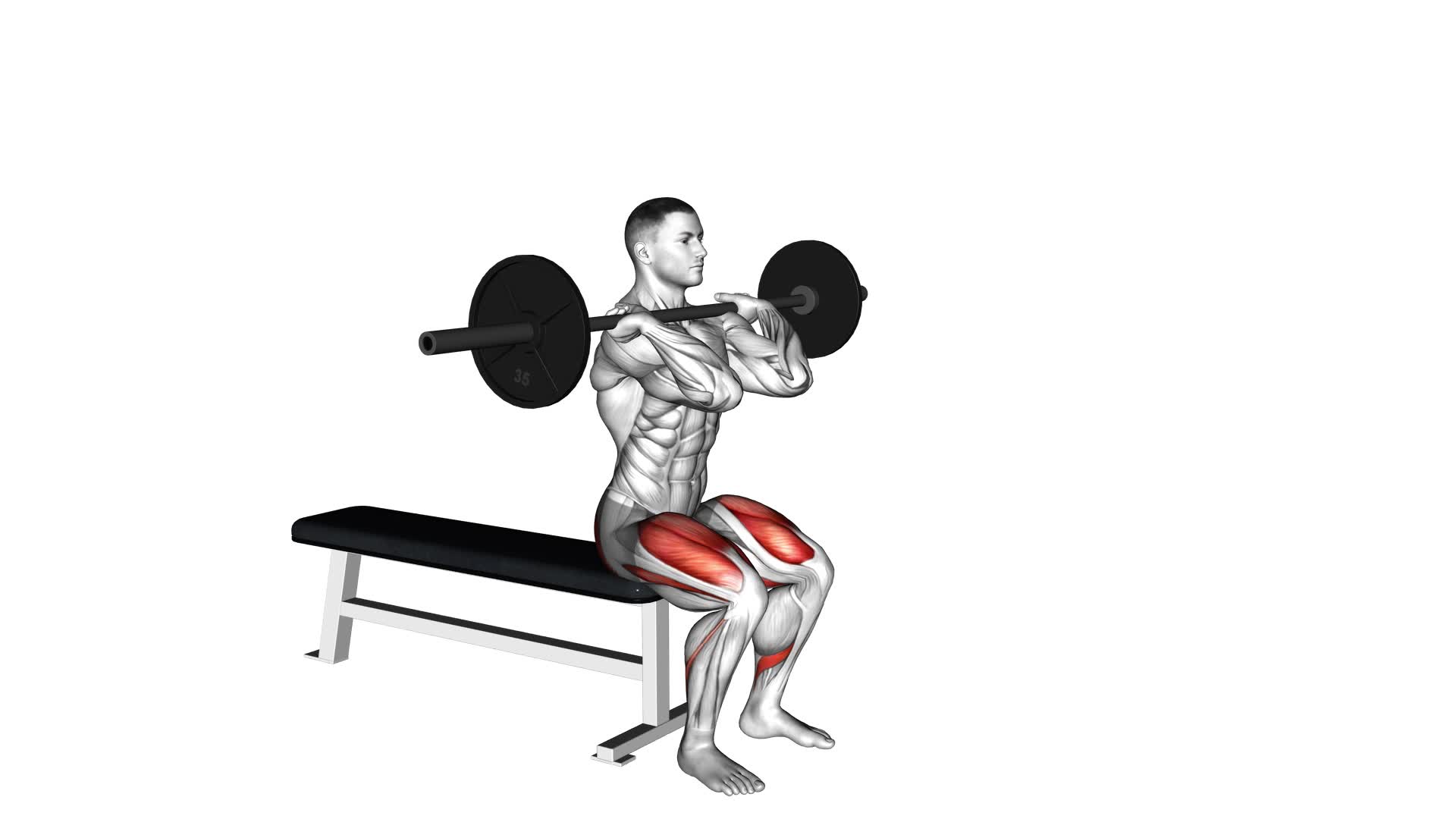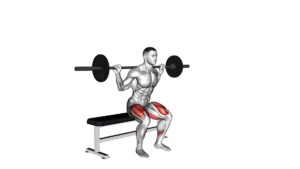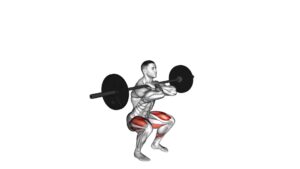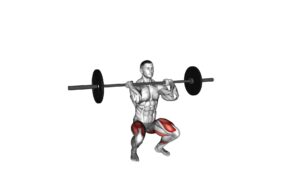Barbell Front Bench Squat – Video Exercise Guide & Tips

Are you looking to add a new challenge to your workout routine? Then the Barbell Front Bench Squat is just what you need! This exercise targets your legs, core, and upper body, giving you a total body workout.
Watch This Exercise Video
In this video exercise guide, we'll show you the proper form and technique, as well as variations to challenge your muscles.
Plus, we'll share valuable tips for maximizing your results and common mistakes to avoid.
Let's get started!
Key Takeaways
- Increased upper body strength and stability
- Improved core stability
- Increased quad activation
- Enhanced overall upper body strength
Benefits of the Barbell Front Bench Squat
You can experience increased upper body strength and stability with the Barbell Front Bench Squat. This exercise offers numerous benefits, including improved core stability and increased quad activation.
By performing the Barbell Front Bench Squat, you engage your core muscles to maintain stability throughout the movement. This helps strengthen your core, which is essential for maintaining proper posture and preventing injuries.
Additionally, the Barbell Front Bench Squat targets your quadriceps, the large muscles in the front of your thighs. As you lower yourself into the squat position, your quads work hard to control the descent and then drive you back up to the starting position. This increased quad activation can lead to stronger and more defined leg muscles.
Moreover, the Barbell Front Bench Squat also helps improve overall upper body strength. As you hold the barbell in front of your body, your shoulders, arms, and chest are engaged to maintain proper form. This can lead to increased strength in these areas, improving your overall upper body stability.
Incorporating the Barbell Front Bench Squat into your workout routine can provide you with these benefits and help you achieve your fitness goals.
Proper Form and Technique
To ensure proper form and technique for the Barbell Front Bench Squat, consistently maintain a neutral spine throughout the exercise. This is crucial for improving stability and reducing the risk of injury.
Start by sitting on the edge of a bench with your feet flat on the ground, shoulder-width apart. Position the barbell across the front of your shoulders, gripping it with your palms facing up and your elbows pointing forward.
As you lower your body into the squat, keep your chest up and your gaze forward. Descend until your thighs are parallel to the ground, or as low as your flexibility allows. Make sure to drive through your heels as you push back up to the starting position.
This exercise targets specific muscle groups, including the quadriceps, glutes, and hamstrings. It also engages your core muscles to maintain stability throughout the movement.
Remember to breathe evenly and avoid any jerking or bouncing motions. By practicing proper form and technique, you can maximize the benefits of the Barbell Front Bench Squat while minimizing the risk of injury.
Variations to Challenge Your Muscles
To further challenge your muscles, incorporate different variations of the Barbell Front Bench Squat into your workout routine. By adding advanced modifications to this exercise, you can increase muscle engagement and take your fitness to the next level.
One variation you can try is the Single-Leg Barbell Front Bench Squat. This variation requires you to balance on one leg while performing the squat. Not only does this challenge your leg muscles, but it also improves your balance and stability.
Another option is the Barbell Front Bench Squat with Resistance Bands. Adding resistance bands to the exercise increases the tension on your muscles, making them work harder and promoting greater strength gains.
If you're looking for a more challenging variation, you can try the Barbell Front Bench Squat with a Pause at the Bottom. This variation involves pausing for a few seconds at the lowest point of the squat, increasing the time under tension and intensifying the workout.
By incorporating these advanced modifications into your routine, you can target different muscle groups and keep your workouts challenging and effective.
Now, let's move on to the next section for tips on how to maximize your results.
Tips for Maximizing Your Results
To maximize your results, incorporate these tips into your Barbell Front Bench Squat routine:
- Proper Form:
Maintaining proper form is crucial for maximizing gains and preventing injuries. Start by positioning the barbell across your shoulders, with your elbows pointing forward. Keep your feet shoulder-width apart and your back straight. As you lower into the squat, ensure your knees stay in line with your toes and your thighs are parallel to the ground. Engage your core and push through your heels to return to the starting position.
- Increase Weight Gradually:
To continue making progress, gradually increase the weight you lift. Start with a weight that challenges you but still allows you to maintain good form. As you become more comfortable and confident, gradually add more weight to continue challenging your muscles and maximizing gains.
- Include Variations:
Incorporating variations of the Barbell Front Bench Squat into your routine can help target different muscle groups and keep your workouts effective. Try adding pauses at the bottom of the squat, performing explosive jumps, or incorporating single-leg squats. These variations will challenge your muscles in new ways and ensure you continue making progress.
Common Mistakes to Avoid
Avoid these common mistakes when performing the Barbell Front Bench Squat to ensure proper form and maximize your results.
One of the most common mistakes people make isn't maintaining a neutral spine throughout the exercise. It's important to keep your back straight and avoid rounding your shoulders. This will help distribute the weight evenly and prevent any unnecessary strain on your lower back.
Another common mistake isn't positioning the bar correctly on your shoulders. Make sure the bar is resting on the front of your shoulders, just below your collarbone. This will provide a stable base of support and allow you to maintain proper form throughout the movement.
Proper depth is also crucial when performing the Barbell Front Bench Squat. Going too low can put unnecessary strain on your knees, while not going low enough can limit the range of motion and reduce the effectiveness of the exercise. Aim to squat until your thighs are parallel to the ground, ensuring that your knees are tracking in line with your toes.
Lastly, it's important to avoid rushing through the exercise. Take your time and focus on maintaining control throughout the movement. This will help engage the targeted muscles and maximize your results.
Frequently Asked Questions
What Are the Potential Risks or Injuries Associated With the Barbell Front Bench Squat?
When performing the barbell front bench squat, there are potential risks and injuries to be aware of. These may include straining your lower back or knees if proper form isn't maintained.
It's important to use a weight that you can handle and to avoid excessive forward lean.
If you have limited mobility or an existing injury, modifications can be made, such as using lighter weights or performing the exercise with a stability ball for added support.
Can the Barbell Front Bench Squat Be Modified for Individuals With Limited Mobility or Injuries?
To modify the barbell front bench squat for individuals with limited mobility or injuries, there are several options.
You can try using a lighter weight or even just your body weight to reduce the strain on your muscles and joints.
Additionally, you can elevate the bench or use a stability ball for added support.
Progressions and regressions for this exercise can also be made by adjusting the depth of the squat or the speed at which you perform the movement.
How Often Should the Barbell Front Bench Squat Be Included in a Workout Routine for Optimal Results?
To achieve optimal results in your workout routine, it's important to include the barbell front bench squat with the right frequency and variations.
This exercise targets your lower body and core, helping you build strength and stability.
Aim to incorporate it into your routine 2-3 times a week, allowing for proper rest and recovery.
To keep things interesting and challenge your muscles, try different variations like using different grips or adding weights.
Remember to always prioritize proper form and listen to your body.
Are There Any Specific Muscle Groups That the Barbell Front Bench Squat Targets?
The barbell front bench squat is an exercise that targets specific muscle groups in your body. It's important to include variations of this exercise in your workout routine for optimal results.
Different fitness levels can benefit from this exercise, as there are modifications available to suit everyone's needs.
Can the Barbell Front Bench Squat Be Performed by Beginners, or Is It More Suitable for Advanced Lifters?
The barbell front bench squat can be performed by beginners, but it's more suitable for advanced lifters. Beginners should focus on mastering the proper form and technique before attempting this exercise.
It requires a good amount of core and upper body strength to maintain stability throughout the movement.
Advanced lifters can use this exercise to further challenge their strength and stability, as well as target specific muscle groups in the lower body and upper body.
Conclusion
In conclusion, the barbell front bench squat is a highly effective exercise for targeting and challenging multiple muscle groups. By maintaining proper form and technique, you can maximize your results and avoid common mistakes.
Additionally, incorporating variations into your routine can further challenge your muscles and prevent plateauing. Remember to always prioritize safety and consult with a fitness professional if needed.
With dedication and consistency, the barbell front bench squat can help you achieve your fitness goals.

Author
Years ago, the spark of my life’s passion ignited in my mind the moment I stepped into the local gym for the first time. The inaugural bead of perspiration, the initial endeavor, the very first surge of endorphins, and a sense of pride that washed over me post-workout marked the beginning of my deep-seated interest in strength sports, fitness, and sports nutrition. This very curiosity blossomed rapidly into a profound fascination, propelling me to earn a Master’s degree in Physical Education from the Academy of Physical Education in Krakow, followed by a Sports Manager diploma from the Jagiellonian University. My journey of growth led me to gain more specialized qualifications, such as being a certified personal trainer with a focus on sports dietetics, a lifeguard, and an instructor for wellness and corrective gymnastics. Theoretical knowledge paired seamlessly with practical experience, reinforcing my belief that the transformation of individuals under my guidance was also a reflection of my personal growth. This belief holds true even today. Each day, I strive to push the boundaries and explore new realms. These realms gently elevate me to greater heights. The unique combination of passion for my field and the continuous quest for growth fuels my drive to break new ground.







